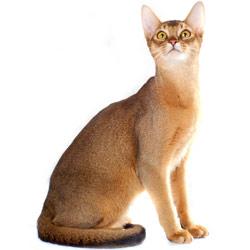Abyssinian

Race: Abyssinian
Nationality: Probably Asian
Standards: Weight (kg): 4 to 7,5 kg
Size: Medium
Type of fur: Short
Colors standards: Hare (black or brown bands on an apricot base), Blue (blue band on a
beige base), Sorrel, Fawn, Red, Chocolate, Lilac and Beige tan.
Origin and history: The Abyssinian is one of the most ancient breeds, however, their origin has
not been established. Perhaps they come from Ethiopia, formerly known as Abyssinia, hence the
origin of their name. In addition, a similar coat to that of the Abyssinian is found in Africa,
Eurasia, and Asia with, among others, Felis Libyca, an African wildcat, and Felis chaus, swamp
cat or jungle cat. However, the existence of tick-cats? in India and Asia would make Asia more
likely. A first "Abyssinian" cat, a cat with the coat like that of a hare, brought back from Ethiopia
by the marshal Sir Robert Napier, would arrive in Great Britain in 1868. His name was Zula, and
he was exhibited in 1871 at the Crystal Palace in London. The breed is officially recognized in
England in 1882. Eventually, it would be bred with the British Shorthair, improving the race.
The development of the breed began in the United States before 1910 and the CFA recognized it
in 1917. Aluna and Osira, two cats born in Vienna, were introduced in France in 1927. Between
1960 and 1970, after the two world wars and a feline leukosis epidemic, the race almost
disappeared.
Personality: The Abyssinian is an active, curious and extroverted cat. He is wary of strangers, but
once he becomes comfortable with us, he can become very attached. He needs space to play and
hunt when he wants, has a strong personality and is independent, however he is very sociable and
affectionate. He also needs a lot of attention.
Notes: The "European" Abyssinian has a larger head, while the "American" Abyssinian has
a more compact body and a rounder, shorter head.
